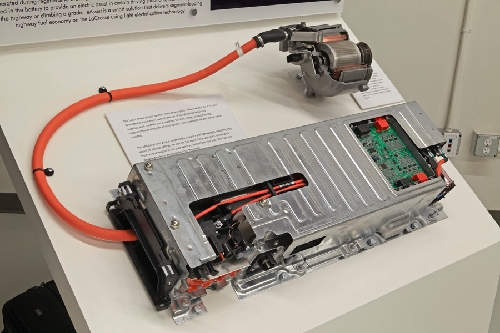Start-stop technology aid to fuel usage
Imagine being stopped at a red light at a busy four-way intersection. Watch the tailpipes of the gasoline-powered cars and trucks around you venting wasted exhaust emissions into the air.
What would happen if the engines on all the stopped cars turned off and did not burn any gasoline until the light changed from red to green? How much fuel would a driver save every year? How much more would it cost an automotive manufacturer to build this feature into every car and truck?
Start-stop technology enables a category of vehicles known as "mild hybrids" or "micro hybrids." These terms describe a vehicle-drive system that automatically shuts down its main internal combustion engine when stopped at a traffic intersection. Then, while the driver releases the brake and presses the accelerator pedal, the engine restarts and the car begins to move again.
Unlike a conventional vehicle, none of the cabin features are lost when the engine is shut down. Heating, air conditioning, headlights and cabin electronics continue to operate when the engine is not running, so the driver does not lose any comfort while waiting for the engine to come back on again.
Micro-hybrid drive trains are different from full-hybrid drive trains used in vehicles like the Toyota Prius because micro hybrids still primarily use a gasoline engine to drive the wheels of the vehicle.
The full-hybrid Toyota Prius uses a battery powered electric traction motor to drive the wheels of the car when first moving forward and accelerating. As battery power drops off or faster acceleration is needed, the gasoline engine takes over to drive the wheels directly in conjunction with the electric motor. Full-hybrid drive trains also have instant on-demand torque available from the electric-traction motor to enable immediate acceleration.
Start-stop technologies might be better described as advanced-engine-starting systems, rather than hybrid systems. However, they do share many of the same components. For example, the battery cells for each system must be capable of providing enough reserve electrical power to achieve many repeated restarts every day, yet still have a normal life cycle of at least five years before replacement. Both systems use sensors to monitor the current state of charge of battery cells and send this data back to an electronic control unit.
Start-stop technology can reduce overall fuel consumption by 10 to 15 percent, depending on vehicle size and daily driving requirements. The average U.S. driver spends at least $1,500 per year on fuel. Annual savings from a start-stop system could start at about $150 per year.
The cost to automotive manufacturers to add start-stop systems to standard gasoline-driven automobiles can be as low as $400 per vehicle, depending upon the type of electric motor and battery cell chemistry used. Full-hybrid systems can cost thousands of dollars more because of the need for more advanced battery cells, a larger electric- traction motor and more complex electronic control systems. Although the fuel efficiency and acceleration performance of a full-hybrid vehicle is greater than micro hybrids, most full hybrids currently have higher upfront price tags that might not be as quickly offset by savings in gasoline consumption.
Start-stop technologies have already caught on in Europe and Asia, where gasoline prices are much higher than in North America.
Since 2007, German automotive parts manufacturer Robert Bosch GmbH has offered an advanced-electric-motor starter system that has been adopted by European automakers, including BMW, Fiat, Volvo and Alfa Romeo.
Toyota, Honda and Mazda have a longer history of implementing this automotive technology within the domestic Japanese market. As early as the mid-1970s, Toyota produced the domestic Crown sedan with a feature that could automatically turn off the car's engine if it idled for more than 1.5 seconds.
Tata Motors in India now installs this feature on several of its small cars for consumers in that country.
For the 2012 model year, South Korean automotive manufacturer Kia Motors will be offering the Rio and Rio5 hatchback in the U.S. market, equipped with an "Idle Stop and Go" or ISG feature to complement a 1.6-liter four-cylinder gasoline engine. The company claims that direct-fuel injection and start-stop technology will provide consumers with a fuel efficiency of 30 mpg in the city and 40 mpg on the highway. The 2012 models will be available at Kia dealerships in the U.S. during the fourth quarter of this year with a base price starting at under $15,000.
Ford Motor Co. also has competed in the European market by installing its Auto Start-Stop system into some of the company's recent European models, including the Ford Focus.
System components include an enhanced 12-volt battery and upgraded starter motor. Ford will begin introducing the Auto Start-Stop system into the North American market on nonhybrid platforms during 2012, coupled with its EcoBoost direct-injection engine technology. The company also announced it plans to scale up the Auto Start-Stop system for larger trucks and SUVs during following years.
General Motors also experimented with micro-hybrid technology from 2005 to 2009 on the Saturn Aura, Saturn Vue, Chevy Malibu and Chevy Silverado before the company went through financial reorganization.
This year GM has revisited and upgraded its "eAssist" system, recently installing it on 2012 models of the Buick LaCrosse and Buick Regal. The eAssist components will include an integrated belt-alternator-starter module that can consistently restart a 2.4-liter Ecotec four-cylinder engine, which in turn recharges a 115-volt lithium-ion battery pack that weighs just 46 pounds.
GM claims that fuel efficiency gained will rate the LaCrosse at 25 mpg/city and 37 mpg/highway. The Buick luxury sedan models will go on sale during the fourth quarter of this year starting around $31,000.
Automotive industry analysts now project that start-stop technology could be installed into 10 million vehicles worldwide by 2015.
Now that's a lot of gasoline saved!
Stan Hanel has worked in the electronics industry for more than 30 years and is a long-time member of the Electric Auto Association and the Las Vegas Electric Vehicle Association. Hanel writes and edits for EAA's "Current Events" and LVEVA's "Watts Happening" newsletters. Contact him at stanhanel@aol.com.














